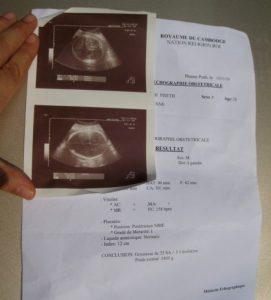¶ 1 Leave a comment on paragraph 1 0 Welcome. Please read the instructions for reviewing before commenting. We ask contributors to be generous when thinking along with our pieces and to keep in mind that the final chapters are intended to be short essays. Visit matteringpress.org for more information on its other books. Readers might also want to have a look at this resource created by one of the book’s editors, Emily Yates-Doerr, which catalogues key Open Access anthropology publications.
¶ 2 Leave a comment on paragraph 2 0 By Jenna Grant
¶ 3 Leave a comment on paragraph 3 0 During her pregnancy, Puthea went to a private maternity clinic for regular ultrasound exams. This clinic was one of the larger and more popular in Phnom Penh at the time (2010) and one that provided echo poar, color ultrasound services.[i] Puthea preferred color to black and white scans because she could see more detail. Following the doctor’s narration, she could recognize feet, legs, and face. Of course, she told me, every ultrasound, even color, has limits to its clarity. “You have to wait until delivery to see what the baby looks like.” Nonetheless, Puthea got one of her later exams at a public hospital, which offered only black and white scans. She did this so that she would be “in the system” there. Puthea could afford a private clinic—she worked in an upscale hotel and her salary, together with her husband’s, placed them in Cambodia’s growing middle class. Yet she chose the public hospital because it offered the best delivery services in Phnom Penh, and was able to handle emergency or complicated cases.
¶ 4
Leave a comment on paragraph 4 0
 Puthea’s black and white ultrasound scans. The cat-like appearance can be seen in the top image.
Puthea’s black and white ultrasound scans. The cat-like appearance can be seen in the top image.
¶ 5 Leave a comment on paragraph 5 0 As many women do, Puthea took a copy of her ultrasound report home with her, and showed the report and accompanying image to her auntie, Ming (see Figure 1). Ming was the matriarch of the family; she helped to raise Puthea and her brother, and owned a popular guesthouse near the riverfront. Puthea was telling me about her most recent experience with ultrasound imaging over dinner at my house, and at this point, she paused. “Ming looked at the scan, and said, ‘It [the fetus] looks like a cat!’” The cat comment was distasteful to Puthea, even though she couldn’t exactly disagree with her auntie. The fetus never looked this way in previous color scans. The black and white image was strange.
¶ 6 Leave a comment on paragraph 6 0 I was hooked by this story, which came to me in the midst of fieldwork on imaging practices. Puthea’s strategies for scanning and delivery were by then familiar—taking into account cost, medical expertise, facility, stage of pregnancy, kind of ultrasound image, among other things. She wanted information that others also wanted from ultrasound exams: information about the sex of the child and when is it due; whether it has its arms and legs, mean dai mean choeng, as people commonly put it; whether its head is up or down; the location of the placenta. However, her story of the cat-like appearance in the image was unusual, and it beckoned; it suggested a porousness of life among others—humans, images, animals, and machines. I wanted to talk to Ming about it. Puthea laughed at my curiousity, but agreed to join me.
¶ 7
Leave a comment on paragraph 7 0
 Ming discusses the ultrasound image.
Ming discusses the ultrasound image.
¶ 8 Leave a comment on paragraph 8 0 When we met in the open lobby of Ming’s guesthouse, calm and quiet in the afternoon heat, Ming stood by her original assessment: “Moel tov?” she asked me. “Perhaps you can you see it, too?” She showed the picture to me, and then to a relative who was visiting from Canada (see Figure 2). Puthea rolled her eyes impatiently. “Or, perhaps the doctor was not so good,” she said. “Or the machine was old and unable to produce good pictures.” Ming had other ideas: perhaps it was because Puthea loved her small black cat too much; she always had it on her lap, petting it, talking to it. And maybe, too, it was because Puthea did not put up enough pretty pictures on the wall to influence the qualities of the fetus in a different direction. Surrounding oneself with nice images could help bring out vitality, health, and beauty.
¶ 9 Leave a comment on paragraph 9 0 Puthea was caught between irritation with her auntie’s “superstitious” line of thinking and feeling somewhat under the sway of cultural logics that connect practices of pregnant women with the physicality of the fetus. Here, visual and affective practices—petting the cat and perhaps loving it too much, not looking at pretty pictures—have material effects. In everyday Buddhist philosophy, conception involves the merger of a new physical form with a consciousness or spirit that has lived previous lives; the fetus is both developing and already developed. Pregnancy is a liminal time where a pregnant woman’s actions can influence the fetus—its form, its nature.[ii] But one need not be committed to Buddhist notions of rebirth and impermanence (or to process ontology) to grasp the plasticity of prenatal life.
¶ 10 Leave a comment on paragraph 10 0 This story is not only about the fetus. It is also about the ultrasound image. Ming suggested that Puthea’s actions and affect caused the fetus to look like a cat in the black and white image. Previous color images had not brought out these qualities. Ming’s reading made me wonder: how can an image intervene onto the object, making it come out better or worse, fixing its fate? People look to ultrasound imaging for clues about how the fetus is developing and what its nature might be. Perhaps they also hope that imaging can shift the process of fetal development, just a little?
¶ 11 Leave a comment on paragraph 11 0 Exceptional stories have an openness and unruliness to them. They require that we think across, diagonal, in staccato leaps. As I have wondered about transforming Puthea’s story into a case, I have looked to quite different conversations for help. Work on “maternal impressions” could help me think about how thoughts, feelings, and actions of pregnant women affect the physiognomy of fetuses.[iii] Work on color can unravel a bit more about color as substance, and as part of postcolonial flows of ornament and vibrancy.[iv] But then, what about black and white? Some consider black and white to be linked to a period of Cambodia’s past, to death, to a notorious set of images, even.[v] Work on portrait photography could help me think about aesthetic practices of relating to images.[vi] For example, concerning photo retouching in Ho Chi Minh City, Nina Hien writes: “Many people considered the photograph as not only as an index of the subject, but also as a live connection to it. Following a popular Vietnamese saying, ‘fixing the image, [could] fix the fate’” (2014: 68). This suggests that images can affect their referents and their beholders; is this partly what was at stake for Puthea and Ming?
¶ 12 Leave a comment on paragraph 12 0 Khmer has a good expression for stories like these: kuor aoy chngual (គួរអោយឆ្ងល់) a story one should wonder about, a story that is surprising, curious, hinting at a different reality than one is used to. Perhaps wonder is what motivates ethnographic case-work, akin to intrigue in medical work.[vii] Exceptional cases do require unusual and unruly accomplices. The work of transforming a story into a case is akin to ‘fixing’ the story, making it come out better or worse. Assembling accomplices shapes what the story is and can be. As I see it, one of the lessons of Puthea’s ultrasound scan is about life as process. Ultrasound is a technique for grasping hold of life to get a sense of what it is and what it may be. Another lesson has to do with the work of images. Cases, like the ultrasound image in this story, may intervene in myriad ways. They intervene on the objects they depict—bringing them out better, fixing certain qualities. They intervene on the readers—how readers sense, think, attune.
¶ 13 Leave a comment on paragraph 13 0 There are ways that exceptional stories fix ethnographers, too. I did not hear about another cat-like scan, yet after talking to Puthea and Ming, I listened more closely for image stories. I asked different questions. I worked to make this story into an exemplary ethnographic case. Can it bear this weight? Perhaps. If representations fix—whether with words, images, or as cases—that fixing is a process, impermanent yet consequential. Fixing the image fixes the fate. Fixing the case shifts what is possible.
¶ 14 Leave a comment on paragraph 14 0 Jenna Grant is Assistant Professor of Anthropology at the University of Washington, where she teaches anthropology of medicine, technology, visuality, and Southeast Asia. She is currently working on a book manuscript titled Seeing clearly: Medical imaging and its uncertainties in Phnom Penh. The book explores histories and contemporary practices of medical imaging in Cambodia’s capital. Jenna also works on projects with Medicine Anthropology Theory(MAT), and Visual & New Media Review, a blog of Cultural Anthropologyonline.
¶ 15 Leave a comment on paragraph 15 0 References
¶ 16 Leave a comment on paragraph 16 0 [i] “Color” ultrasound services can refer to Doppler imaging, 3D imaging, or a background tint or platform on 2D images. Puthea was talking about color 2D images. French and Khmer in the expression echo poar indicate the mixtures that make up Cambodian medicine: echo is from the French echographie for ultrasound and poar is the Khmer term for color. A great history of this medicine is Sokhieng Au (2011) Mixed Medicines: Health and Culture in French Colonial Cambodia. University of Chicago Press.
¶ 17 Leave a comment on paragraph 17 0 [ii] See Ang, C (1982) Grossesse et Accouchement au Cambodge: Aspects Rituels. ASEMI 13(1-4): 87-109.
¶ 18 Leave a comment on paragraph 18 0 [iii] On maternal impressions see, for example: Morgan, L (2003) Embryo Tales. In Franklin, S and Lock, M (Eds.) Remaking Life and Death: Toward and Anthropology of the Biosciences. Pp. 261-229. School of American Research Press; Stafford, B (1991) Body Criticism: Imaging the Unseen in Enlightenment Art and Medicine. MIT Press; or Taylor, J (2008) The Public Life of the Fetal Sonogram: Technology, Consumption, and the Politics of Reproduction. Rutgers University Press.
¶ 19 Leave a comment on paragraph 19 0 [iv] See Galt, R (2011) Pretty: Film and the Decorative Image. Columbia University Press; or Taussig, M (2009) What Color Is the Sacred? University of Chicago Press.
¶ 20 Leave a comment on paragraph 20 0 [v] On the Tuol Sleng photographs, see French, L (2002) Exhibiting Terror. In Bradley, MP and Petro, P (Eds.) Truth Claims: Representation and Human Rights. Pp. 131-55. Rutgers University Press.
¶ 21 Leave a comment on paragraph 21 0 [vi] I look to Hien, N (2014) Photo Retoucher. In Barker, J, Harms, E, and Lindquist, J (Eds.) Figures of Southeast Asian Modernity. Pp. 67-69. University of Hawai’i Press; Pinney, C (2003) Notes from the Surface of the Image: Photography, Postcolonialism, and Vernacular Modernism. In Pinney, C and Peterson, N (Eds.) Photography’s Other Histories. Pp. 202-220. Duke University Press; and Strassler, K (2010) Refracted Visions: Popular Photography and National Modernity in Java. Duke University Press.
¶ 22 Leave a comment on paragraph 22 0 [vii] On intrigue as a motivation for diagnostic work in medicine, see Saunders, B (2008) CT Suite: The Work of Diagnosis in the Age of Invasive Cutting. Duke University Press.


Comments
0 Comments on the whole Page
Login to leave a comment on the whole Page
0 Comments on paragraph 1
Login to leave a comment on paragraph 1
0 Comments on paragraph 2
Login to leave a comment on paragraph 2
0 Comments on paragraph 3
Login to leave a comment on paragraph 3
0 Comments on paragraph 4
Login to leave a comment on paragraph 4
0 Comments on paragraph 5
Login to leave a comment on paragraph 5
0 Comments on paragraph 6
Login to leave a comment on paragraph 6
0 Comments on paragraph 7
Login to leave a comment on paragraph 7
0 Comments on paragraph 8
Login to leave a comment on paragraph 8
0 Comments on paragraph 9
Login to leave a comment on paragraph 9
0 Comments on paragraph 10
Login to leave a comment on paragraph 10
0 Comments on paragraph 11
Login to leave a comment on paragraph 11
0 Comments on paragraph 12
Login to leave a comment on paragraph 12
0 Comments on paragraph 13
Login to leave a comment on paragraph 13
0 Comments on paragraph 14
Login to leave a comment on paragraph 14
0 Comments on paragraph 15
Login to leave a comment on paragraph 15
0 Comments on paragraph 16
Login to leave a comment on paragraph 16
0 Comments on paragraph 17
Login to leave a comment on paragraph 17
0 Comments on paragraph 18
Login to leave a comment on paragraph 18
0 Comments on paragraph 19
Login to leave a comment on paragraph 19
0 Comments on paragraph 20
Login to leave a comment on paragraph 20
0 Comments on paragraph 21
Login to leave a comment on paragraph 21
0 Comments on paragraph 22
Login to leave a comment on paragraph 22